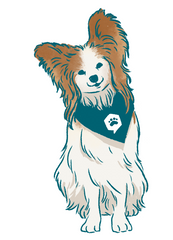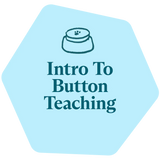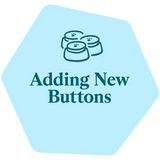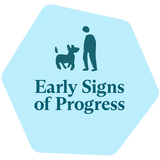We recommend starting with 2-3 buttons. If you start with too many buttons at once, your learner might have a hard time learning each individual concept, but having more than one helps them understand each button means a different thing.
- Motivating & meaningful to your learner
- Easy & convenient to model
- Healthy to model & respond “yes” to frequently
- Tangible, concrete, or actionable (not abstract)
Give them a good reason to use the soundboard. They should be motivated enough to have an interest in using the soundboard to request their favorite things, but not so excited they become unable to think or interact with the soundboard. Find that sweet spot of motivation.
Using your learner’s Motivation Tower, review the items you have listed in the “Reasonably Motivating” “Very Motivating” and “Super Motivating” sections. Do any of these seem like they could be incorporated into a concept you want to teach your learner? Would they make a good first button according to the list above? Test other concepts that fulfill the list to see where they fall on your learner’s motivation tower to help you decide which buttons to add first.
Start with concepts you are willing and able to model over and over. You’ll be modeling your starting words constantly during the first couple of weeks as your learner builds an understanding of how to use the buttons. The best word choices can be responded to immediately and are convenient enough to model repeatedly so you won’t burn yourself out. The more repetition, the more they learn. We’ll introduce the “brakes” later. During this phase of learning, focus on developing your learner’s desire to press buttons by showing them using buttons can get them where they want to go.
Say yes! Early buttons need positive responses. Say “yes” as often as you can. Avoid choosing a button that you can’t respond to positively most of the time while keeping your learner safe and healthy. If that’s TREAT or FOOD, be prepared to give a lot of small meals or tiny portions of kibble throughout the day, and ensure they aren’t overfed. If it’s WALK, you’ll need to take them on small, manageable walks when the button is pressed for a little while.
Begin with buttons that have clear meanings. Some concepts are more straightforward to model than others. Start with tangible, concrete, actionable concepts (e.g. SCRITCHES, PLAY) that your learner can easily comprehend and form firm associations with. They need to understand when this button is pressed, this specific thing happens. Think about things your learner is already familiar with, regardless of whether it has a word paired with it yet. Ideally, these are things they already ask for with natural communication. Introducing abstract concepts like LOVE YOU or MAD too early might prevent them from forming the desired associations with each button which can hinder overall progress and comprehension long term.

Did you know? When a behavior disappears because it was ignored and no longer reinforced (or rewarded) it’s called extinction. Extinction is one reason why it is so important to respond affirmatively, quickly, and consistently to your learner’s early button presses — we want to avoid accidentally extinguishing their pressing behavior before they really learn how to use the soundboard.
Is this concept a good starting button?
I will use this word consistently around my learner and/or my learner already recognizes it
This concept is adequately motivating and meaningful to my learner
This concept is concrete, clear, or actionable (not an abstract concept)
This concept can be easily and regularly modeled for my learner
I can and am willing to say “yes” to what this button means over and over
If you’ve checked off all of the above, you have an appropriate starting button. If you were not able to check off all the above, we recommend returning to review your learner’s Motivation Tower, Motivating Your Learner section and How to Model section.
Common Early Concepts
Every learner is unique! That’s why we want to give you the tools to decide what is best for you and your individual learner. The following considerations should help you make informed decisions about the best concepts to start with for your learner.
OUTSIDE is the most common first word. It’s pretty motivating for most learners, is often already part of daily routines, and can be easily modeled repeatedly. Even if your learner isn’t let out into a traditional yard, variations of this like PATIO/CATIO or DECK can be appropriate equivalents. For indoor cats, OPEN is sometimes a good variant if they always want closed doors to be opened.
SCRITCHES is also a great starting concept with hardly any drawbacks. It’s easy to model frequently and decently motivating to most learners. It also can be a calming experience for some learners, which may offer a nice counterbalance to other, more exciting starting buttons. However, a more exciting button may be necessary to get many learners started.
PLAY has some unique features that make it a great core word on any soundboard. It’s generally highly motivating which makes it a fantastic starting button if you and your learner enjoy playing together. It’s a great stepping stone for introducing multi-button presses with different game and toy combinations like TUG, BALL, and FLIRT POLE. There is a chance this could be too arousing for some learners, similar to how learners can become over-excited by food so keep an eye out for that. Check out PLAY TUG or BALL Modeling Games.
Did you know? Play is considered a universal language.
TREAT is highly motivating for most learners and often becomes a learner’s MVB (most valuable button). Be careful using this as a starting button with overly food-motivated learners. We often reward our learners with treats for performing obedience behaviors or tricks. This can be confusing to them if we aren’t careful. It’s essential the learner recognizes they receive a treat only for pushing the TREAT button as opposed to thinking they will receive a treat for pushing any button. They’ll struggle to learn the meaning of individual buttons if they think everything means TREAT. If it’s difficult to find a starting concept your learner has enough interest in, this button offers a lot of repetition potential…like a LOT of repetitions. When some learners are first given agency about their food, they sometimes overindulge. If your learner is on a diet or is so food motivated you suspect they’ll never stop asking for food no matter how much they get, wait to introduce TREAT until after they’ve learned ALL DONE. Consider introducing creative alternative buttons such as PUZZLE (e.g., food puzzle, snuffle mat, Kong, etc.) or TRAINING/TRICKS (i.e., do/perform tricks or practice obedience) to allow them to request an opportunity to earn a delicious tidbit via interactive or solo activities.
Planning Ahead: Many people choose to differentiate between FOOD meaning a full meal and TREAT meaning a snack but you may decide to stick with just one or the other.
Pro Tip: TREAT makes the perfect target training button even if you don’t want to leave it down as one of your learner’s first permanent words. This allows you to still teach this button/concept early on, even if you have to wait until after they learn ALL DONE to add it to their soundboard.
WALK is a highly motivating concept for a lot of learners. It involves a bit more time and effort commitment from you to model and respond repeatedly but it’s a fantastic excuse to get some exercise while bonding with your learner. If you can’t stop what you’re doing to take them for a bunch of mini-walks throughout the early days, wait to introduce WALK until after they’ve learned ALL DONE or NOW vs LATER. If you live in a particularly cold or hot climate, WALK may be less attractive to your learner (and you) depending on the season. It may also be more difficult to readily respond to requests since it can take more time to prepare for the excursion (winter gear, sunscreen, etc.)
Did you know? Dogs often become most attached to the individual who walks them. Exploring the world together is a great bonding activity!
WATER might not be the most exciting button for every learner but it is a primary need, making it a valuable concept and practical button. Playing Water Modeling games can help increase the value of this button to make it more interesting and fun for your learner.
Did you know? Within 24 hours, dogs and cats become dehydrated without water. Three days without water is fatal for many living things (humans included).
WANT is a good button to begin modeling two-button combinations with other buttons your learner already knows on your soundboard. It’s easy to introduce by simply modeling WANT OUTSIDE, WANT SCRITCHES, WANT WATER, etc. the same way you were modeling the words without WANT. It also gives them a way to ask for things they don’t have a button for by using WANT and then directing you with their natural communication. This can help you identify additional buttons they might use.
ALL DONE While it’s an essential button, we recommend putting off introducing ALL DONE for as long as you can handle your learner’s level of button use. You can begin verbally modeling it by saying “all done” at the end of activities you are all done with during your daily routine such as “walk all done” or “all done dinner.” Don’t use it for things you’re willing to do right away again if asked (like the buttons you are currently modeling) because it needs to mean “all done for real.”
Introducing ALL DONE as a button with other button concepts too soon can actually extinguish their button pressing if it isn’t well enough established or they haven’t had enough time to concretely process what they’ve been learning. That being said, if you’ve been doing it right and running around responding to button presses left and right for a week or two, then this is how you get your life back. Just kidding… sort of… we know it can be a lot in the beginning, but it is so worth it!
Know your learner
High-drive learners and learners who struggle with self-regulation will need ALL DONE added sooner compared to more reserved or timid button users who will likely benefit from waiting until they’ve interacted with the soundboard enough to introduce that concept.
If you have questions or feedback regarding this content, please email us at learning@fluent.pet














Leave a comment
This site is protected by hCaptcha and the hCaptcha Privacy Policy and Terms of Service apply.